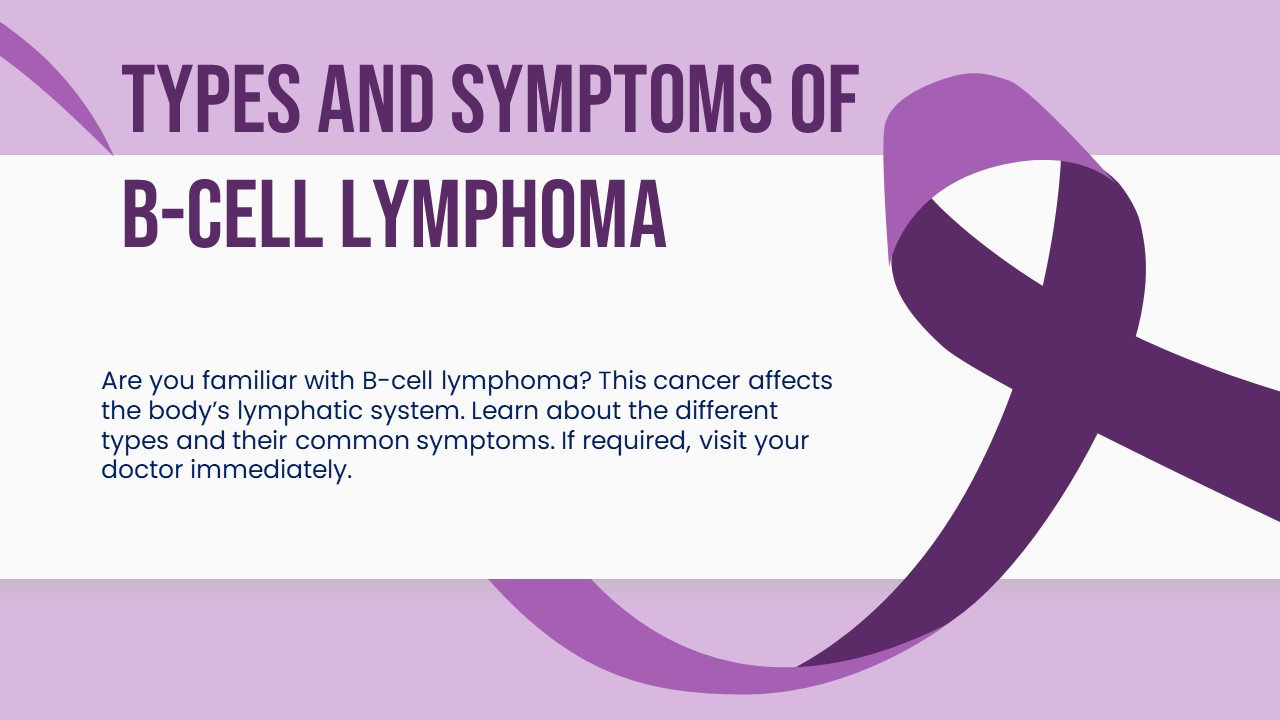Types and Symptoms of B-cell Lymphoma - PowerPoint PPT Presentation
Title:
Types and Symptoms of B-cell Lymphoma
Description:
Are you familiar with B-cell lymphoma? This cancer affects the body’s lymphatic system. Learn about the different types and their common symptoms. If required, visit your doctor immediately. – PowerPoint PPT presentation
Number of Views:1
Title: Types and Symptoms of B-cell Lymphoma
1
Types and Symptoms of B-cell Lymphoma
- Are you familiar with B-cell lymphoma? This
cancer affects the bodys lymphatic system. Learn
about the different types and their common
symptoms. If required, visit your doctor
immediately.
2
What is B-Cell Lymphoma?
- B-cell lymphoma cancer grows in the B cells,
known as B lymphocytes, which make antibodies to
fight disease-causing microbes. Most B-cell
lymphomas are non-Hodgkin lymphoma (NHL). - NHL is the name for a group of cancers that
affect the immune systems white blood cells.
B-cell lymphomas generally occur in lymph fluid
and lymph nodes but may also occur in other parts
of your immune system like bone marrow or the
spleen. They may also spread to other parts of
your body such as the liver and brain.
3
Different Types of B-Cell Lymphomas
- As mentioned, B-cell lymphoma affects the B cells
which are part of the immune system. There are
different types that vary depending on where the
cancer originates. - Diffuse Large B-Cell Lymphoma (DLBCL)
- Follicular Lymphoma
- Mantle Cell Lymphoma
- Chronic Lymphocytic Leukemia (CLL) / Small
Lymphocytic Lymphoma (SLL) - Marginal Zone Lymphomas
- Lymphoplasmacytic Lymphoma (Waldenstrom
Macroglobulinemia or WM) - Burkitt Lymphoma
- Hairy Cell Leukemia
4
Diffuse Large B-Cell Lymphoma (DLBCL)
- This variety attacks all age groups but mostly
occurs in the elderly. It starts as a
rapidly-growing mass inside lymph nodes in the
abdomen, chest, armpit or neck. It may also begin
in other parts of your body like the intestines,
brain, bones or spinal cord. This tends to be an
aggressive and fast-growing cancer but usually
responds very well to treatment.
5
Follicular Lymphoma
- Follicular lymphoma appears in several lymph node
sites such as the chest and abdomen. It also
occurs in bone marrow but it is slow growing.
Mostly elderly people suffer from this lymphoma
as it rarely occurs in young people.
6
Mantle Cell Lymphoma
- This lymphoma mainly affects men over 60. By the
time it is detected it has already spread to your
bone marrow, spleen, and lymph nodes. It is more
challenging to treat than other B-cell lymphomas.
7
Chronic Lymphocytic Leukemia (CLL) / Small
Lymphocytic Lymphoma (SLL)
- In this slow-growing B-cell lymphoma, the cancer
cells are mostly seen in the blood and bone
marrow, as well as the spleen and lymph nodes.
8
Marginal Zone Lymphomas
- Like CLL and follicular lymphoma, this is also
slow-growing. Some of these lymphomas occur in
the thyroid, lungs, salivary glands, tissues
surrounding the eyes, and skin.
9
Lymphoplasmacytic Lymphoma (Waldenstrom
Macroglobulinemia or WM)
- This is a slow-growing and rare lymphoma that
affects the spleen and liver. It produces an
immunoglobulin or antibody known as M-protein.
10
Burkitt Lymphoma
- This fast-growing B-cell lymphoma mostly affects
the stomach.
11
Hairy Cell Leukemia
- In spite of the name, this cancer is often
regarded as a kind of B-cell lymphoma. It is a
rare lymphoma mostly suffered by men. The cells
are tiny B lymphocytes with projections coming
out that give them a hair-like appearance. They
are seen in the blood, bone marrow, or spleen.
12
Symptoms of B-Cell Lymphoma?
- Symptoms vary depending on the type of B-cell
lymphoma, how advanced it is, and where it
appears. For example, a person with lymphoma in
the chest may experience chest pain,
breathlessness, and coughing. - The most common sign of B-cell lymphoma is an
enlarged or swollen lymph node in the groin,
armpit, or neck. These inflamed lymph nodes are
generally painless. However, they may create
pressure on surrounding organs or tissues and
cause pain and discomfort. - Other common symptoms are unexplained tiredness,
a rash, or itchy skin on the back, stomach, or
chest. - Some signs of this lymphoma are generalized which
means they can affect your entire body. (They are
called systemic or B symptoms.) These include
drenching night sweats, an unexplained high fever
that wont go away, and unexplained weight loss. - A cancer diagnosis is a matter of concern, but
most B-cell lymphomas respond well to treatment.
Early detection and treatment can bring excellent
results, even in those with an aggressive cancer.
Never delay seeing a doctor about an inflamed
lymph node or any other above-mentioned cancer
symptoms. - Consult healthcare professionals, caregivers, or
support groups like Lymphoma Canada to learn more
about this serious disease and how to deal with
it.































